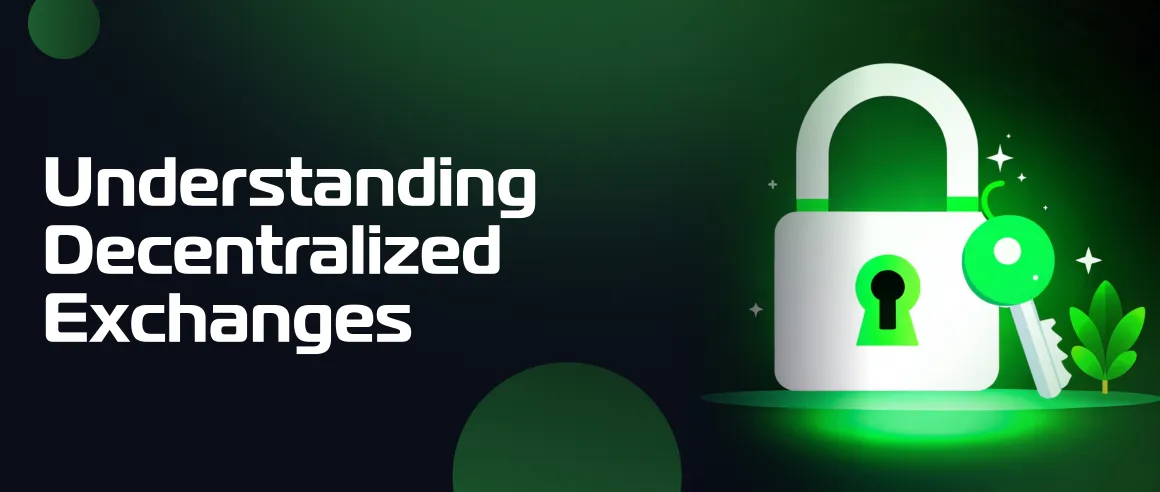Previously, we’ve studied the concept of DeFi and the outlooks of the emerging financial ecosystem. Today, we will delve into Decentralized Exchanges — an essential component of the decentralized economy. In the same way as NFTs introduced the new concept of digital ownership, DEXs are rebuilding how we trade and exchange digital assets.
What are decentralized exchanges?
A decentralized exchange is a peer-to-peer (p2p) marketplace where cryptocurrency traders (buyers and sellers) connect to conduct transactions directly without an intermediary. Unlike centralized exchanges (CEXs) or traditional banks that manage and exchange funds through their internal protocols, DEXs conduct transactions using smart contracts on a blockchain. Smart contracts are rules for successful transactions specified in an algorithm. If the terms for a transaction are not met, the transaction doesn’t go through or reverses. This approach guarantees fraud resistance and independence.
The evolution of DEXs
The concept of DEX has been actively evolving along with the cryptocurrency market. From the start, centralized exchanges dominated due to their user-friendly interface, high liquidity, and government regulation. The latter was a key factor for people who were suspicious of crypto — the new type of money.
However, as the demand for privacy and independence grew, the limitations of CEXs became critical for some users. Those limitations and flaws included vulnerability to hacks, regulatory scrutiny, and tedious identity verification. DEXs were a solution to eliminating these flaws and expanding the array of instruments available for cryptocurrency users. Nowadays, DEXs are services that fully correspond to the core principles of a decentralized economy.
How do DEXs work?
Blockchain and smart contracts
The base of a DEX is blockchain. Blockchains are distributed ledgers that record all transactions. Smart contracts are terms of some deal written as code executed on a blockchain. Smart contracts are self-executing; thus, they automate the trading process. When a user initiates a trade on a DEX, a smart contract ensures that the conditions of a trade are met. If everything is in order, the transaction goes through and stays on the blockchain forever. If some conditions of a trade are not met, the transaction reverses, and a user gets their money back. This process is vital to minimizing the need for intermediaries and reducing the risk of hacks, fraud, and regulatory roadblocks.
Order Book vs. Automated Market Makers (AMMs)
There are two main types of decentralized exchanges: order book DEXs and automated market makers (AMMs). Let’s examine them and determine their differences.
Order book DEXs: Such decentralized exchanges operate similarly to traditional exchanges. They record buy and sell orders and match them to conduct trades. They offer greater control over trading but may suffer from lower liquidity and transaction delays compared to centralized exchanges.
Automated Market Makers (AMMs): AMMs revolutionized the concept of DEX, removing the need for an order book. They use liquidity pools instead. In liquidity pools, users provide funds to conduct trading. The prices are determined based on the pool's supply and demand ratio. One of the most popular DEXs, Uniswap, utilizes this model, providing an agile and seamless service.
Liquidity pools and yield farming
Liquidity pools are essential to AMMs. As liquidity providers, users deposit pairs of currencies into the pools in return for trading fees proportional to the size of their contribution. This acts as an incentive for users to provide the pool with liquidity. High liquidity ensures that the trades can be executed without prices slipping.
Yield farming is a process where users stake their crypto in DeFi protocols for rewards. This often involves contributing to liquidity pools. Users who participate in yield farming earn additional tokens, thus enhancing the liquidity and stability of a DEX.
Advantages of DEXs
Enhanced Security
DEXs do not hold users’ funds, significantly reducing the risk of large-scale hacks. Users keep control of their money with private keys, drastically decreasing the danger of losing their assets to an exchange’s infrastructure breaches. This security model aligns with the overall logic of decentralized services and blockchain technology.
Privacy and anonymity
DEXs do not require a KYC (know your customer) procedure, which enhances privacy compared to CEXs.
Less reliance on intermediaries
DEXs reduce human error by eliminating intermediaries. Trades are executed through smart contracts that ensure that all terms are met without the need for third parties.
Challenges and limitations
Liquidity issues
Due to the mechanisms of DEXs’ work, they are prone to liquidity issues. This is particularly true for less popular tokens — low liquidity causes price slippage, making it more difficult for a DEX user to execute large trades. Although AMMs and liquidity pools fix the issue somewhat, it is still a significant problem.
User interface
The interface design of DEXs is far less intuitive than that of centralized exchanges. As users need to manage private keys and interact with complex interfaces, the services remain difficult and sometimes even non-accessible for newcomers. However, many developments are ongoing. Soon, we might see a new generation of DEXs with a more intuitive interface.
Scalability and speed
High transaction volumes lead to increased fees and slowing down the network. This impacts the trading experience and raises concerns about scalability issues.
The outlooks of DEXs
The technology continues to evolve, promising a bright future for the ecosystem of DeFi solutions. Innovative features like cross-chain trading enable transactions and exchange across different blockchain networks. The growing demand for privacy, security, and decentralized finance protocols fuels the evolution of DEXs.
Decentralized exchanges offer a secure, transparent, and actively developing alternative to centralized exchanges for transactions with digital funds. While there are challenges like scalability and liquidity shortages, the ongoing development promises to resolve these issues.
Read more: What Is Decentralized Finance?
Tags:
Share:
